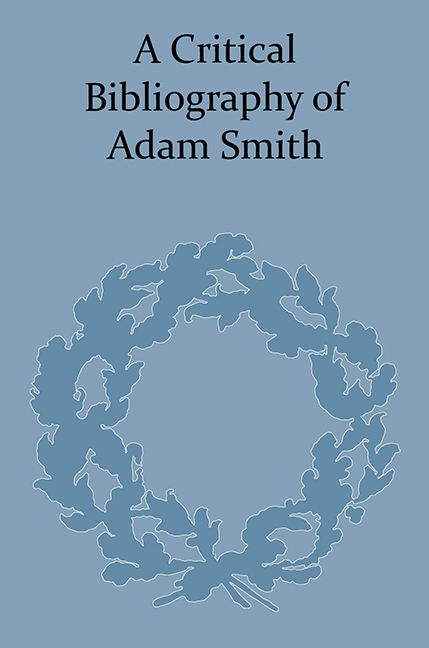Book contents
- Frontmatter
- CONTENTS
- Acknowledgements
- General Introduction
- Early Editions of Adam Smith's Books in Britain and Ireland, 1759–1804
- Adam Smith in English: From Playfair to Cannan
- The Glasgow Edition of the Collected Works of Adam Smith
- The Diffusion of the Work of Adam Smith in the French Language: An Outline History
- The German Reception of Adam Smith
- Adam Smith in Russian Translation
- The Reception of Adam Smith's Works in Poland from the Eighteenth to the Twentieth Centuries
- Adam Smith in the Spanish- and Portuguese-speaking World
- Translations of Adam Smith's Works in Japan
- Adam Smith in China
- Notes to the Bibliographies
- Main Bibliography: All Editions, Chronologically Ordered
- Bibliography by Individual Work
- Bibliography by Language Group
- Note on Dutch Editions
- Note on Italian Editions
- Note on Romanian Editions
- Index
Early Editions of Adam Smith's Books in Britain and Ireland, 1759–1804
- Frontmatter
- CONTENTS
- Acknowledgements
- General Introduction
- Early Editions of Adam Smith's Books in Britain and Ireland, 1759–1804
- Adam Smith in English: From Playfair to Cannan
- The Glasgow Edition of the Collected Works of Adam Smith
- The Diffusion of the Work of Adam Smith in the French Language: An Outline History
- The German Reception of Adam Smith
- Adam Smith in Russian Translation
- The Reception of Adam Smith's Works in Poland from the Eighteenth to the Twentieth Centuries
- Adam Smith in the Spanish- and Portuguese-speaking World
- Translations of Adam Smith's Works in Japan
- Adam Smith in China
- Notes to the Bibliographies
- Main Bibliography: All Editions, Chronologically Ordered
- Bibliography by Individual Work
- Bibliography by Language Group
- Note on Dutch Editions
- Note on Italian Editions
- Note on Romanian Editions
- Index
Summary
Theory of Moral Sentiments
Smith's first book was published in London at the end of April 1759 with the simple title The Theory of Moral Sentiments. It is a one-volume octavo of 550 pages, with thirty narrow lines (about 200 words) to the page. The title page identifies the author as ‘ADAM SMITH, Professor of Moral Philosophy in the University of Glasgow’, and the co-publishers as A. Millar, in the Strand, and the Edinburgh firm of A. Kincaid and J. Bell. The book was printed in April 1759 by William Strahan, whose ledgers record a print run of 1,000 copies. In a letter of 26 April, Andrew Millar told the author that the printing required thirty-four sheets, on the basis of which he planned to sell the book for six shillings bound.
Sales were brisk. Shortly before publication, David Hume told Smith that ‘Millar exalts and brags that two thirds of the Edition are already sold, and that he is now sure of Success’. Two weeks later, Millar himself told Smith that he had ‘no Sort of doubt of this Impression being Soon gone tho’ it will not be published till next Week'. Under these circumstances, Millar gave Smith ten presentation copies as a gift, and for the remaining eight presentation copies he charged him the same low rate given to booksellers who ordered at least a certain number. It is clear from Millar's letter that Smith had sold the copyright before publication, two-thirds to Millar and one-third to Kincaid & Bell. We do not know how much copy money Smith received for Theory of Moral Sentiments, but it almost certainly was not very much, given the format and price of the book.
After Smith made revisions and corrections, Strahan printed 750 copies of the second edition in September 1760. Responding to criticism by Hume and Gilbert Elliot, Smith had revised his central concepts of sympathy and the impartial spectator.
- Type
- Chapter
- Information
- A Critical Bibliography of Adam Smith , pp. 13 - 26Publisher: Pickering & ChattoFirst published in: 2014



